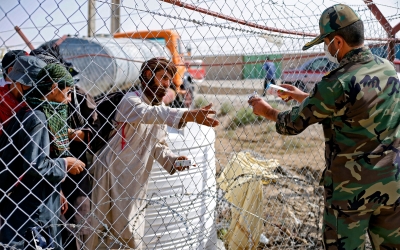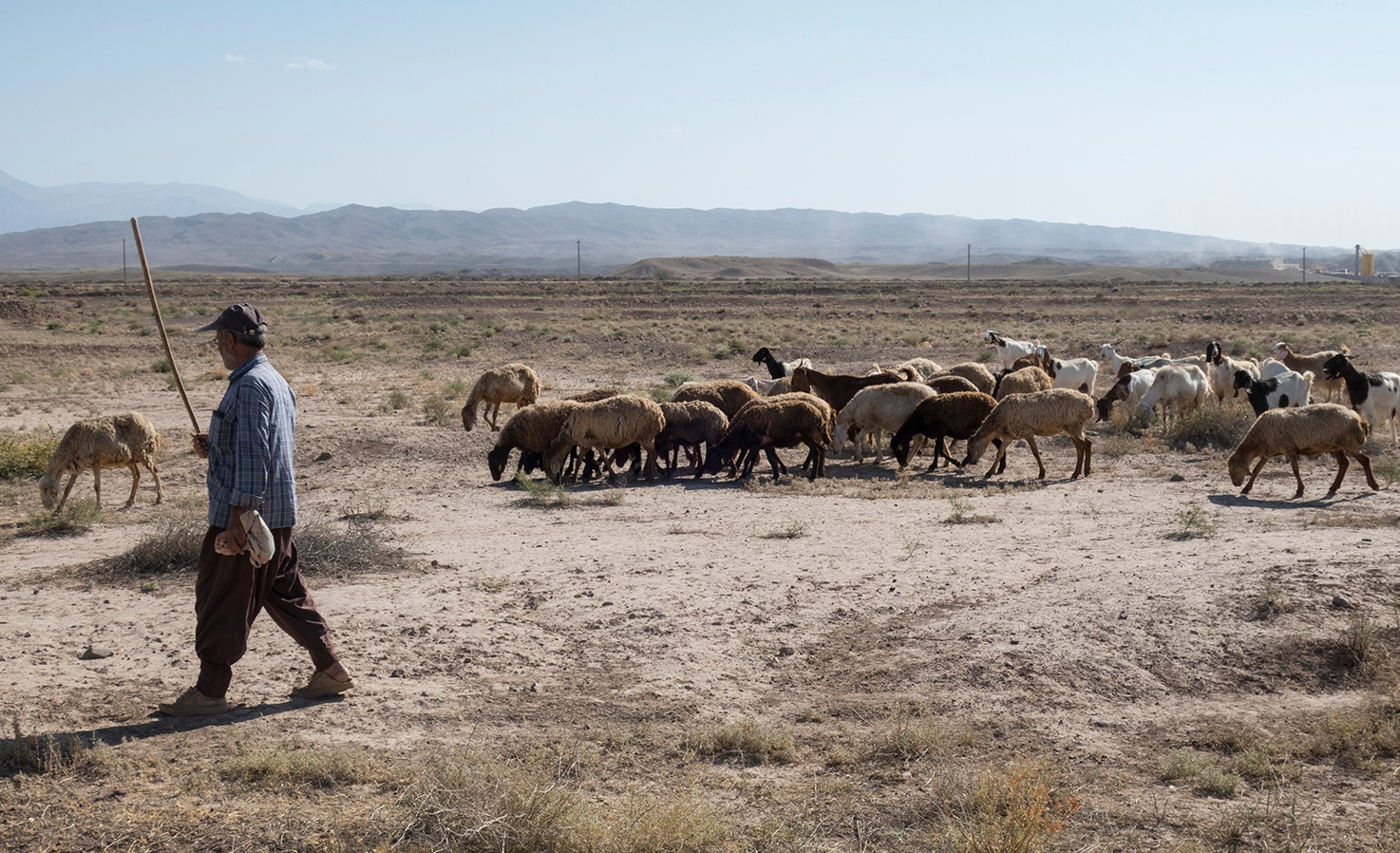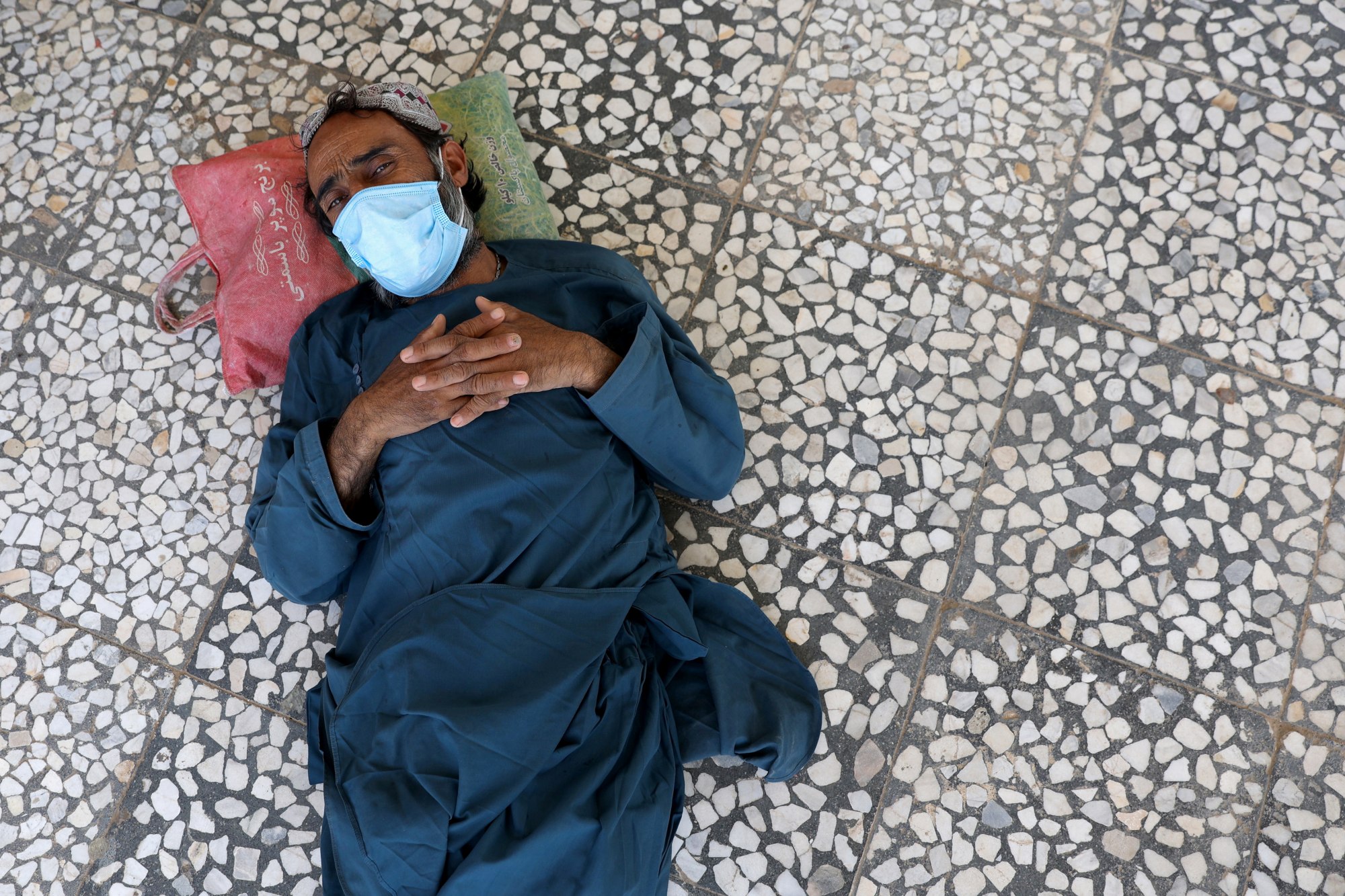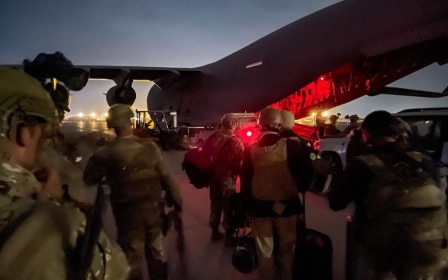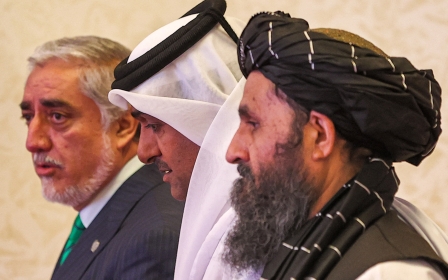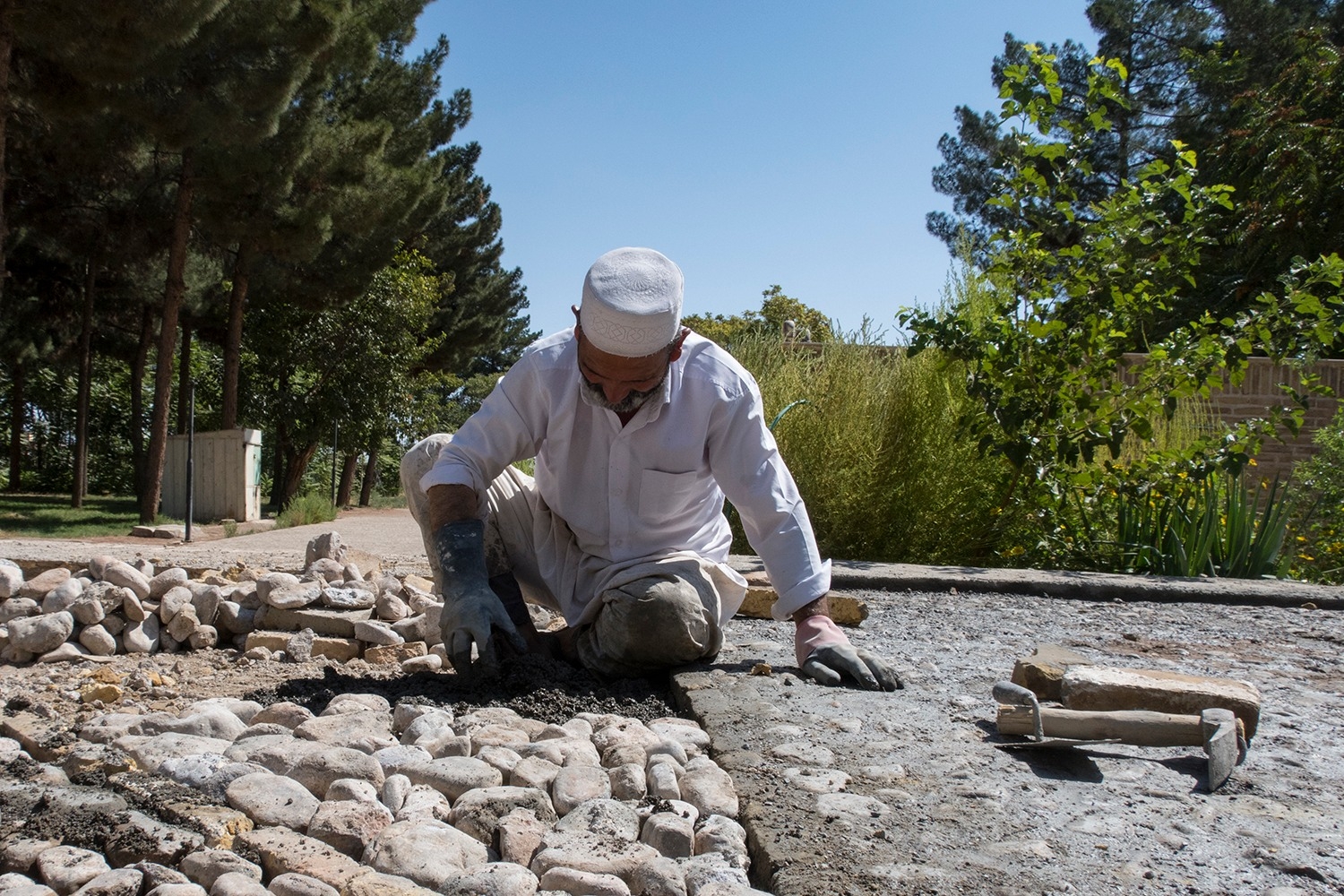
‘Nothing is certain’: The precarious lives of Afghans in Iran
Taybad, Iran — As a minivan stops to refuel at a gas station on the outskirts of the city of Taybad, its passengers hurry to the nearby mosque to perform the sunset maghrib prayer. A sign tucked on the back window of the vehicle indicates its arrival and departure points: Herat-Mashhad, a nearly 400-kilometre journey between Afghanistan and Iran.
The minivan is one of only a handful of passenger cars manoeuvring between fuel tanks and trucks driving unrushed on the bumpy road tracing a long, straight line through the arid desert landscape between the two countries.
A talkative man dressed in traditional Afghan clothing, the van driver speaks with assurance about the movement of people at the border.
"I've been driving on this route for the past 20 years. I know all the officers on both sides of the border - however, new people are now in charge on the other side," he says, referring to the return of Taliban rule in Afghanistan last month.
Immediately after the power grab by the Taliban, the number of passengers travelling between the two countries decreased, the driver says. "But now it's getting back to normal," he adds, wiping big beads of sweat from his forehead with a colourful Afghan scarf.
The minivan’s passengers, five men in their forties and fifties, are reluctant to talk, arguing that they cannot speak Farsi, the official language of Iran also spoken in some parts of Afghanistan.
The driver is only too happy to appoint himself as their spokesman: "They are from Qala-e-Naw and have some family members in Mashhad. Many Afghans are like that. For now, they go to Mashhad and work there for a while. If the situation is calm in Afghanistan, they will return; if war erupts again, they will find another way."
For Afghans with no money or connections, Iran and Pakistan have long been the most common destinations to flee four decades of conflict in their home country - nearly 85 percent of the 2.6 million Afghan refugees registered with the United Nations globally live in these two neighbouring states. Some three million Afghans, many of them undocumented, are estimated to live in Iran.
After the Soviet-Afghan war of 1979-1989, civil war and the Taliban’s first period of rule in the 1990s, and two decades of the so-called “war on terror” in the wake of 9/11, the withdrawal of US forces in August and the near-immediate takeover by the Taliban has once again sowed chaos in Afghanistan.
While Tehran has made cautious overtures to the new Taliban government, Iranian authorities have been evasive about the expected influx of Afghans into the country.
"There are no refugees, it's all normal over there, and you'd better go back home," says an Iranian officer manning a checkpoint close to the Dougharoun border crossing.
But for Afghans living in the country, many of them for decades, “normal” is anything but.
Four decades of back and forth
Over the span of 42 years, countless Afghans have moved back and forth between their home country and Iran depending on the fluctuations of conflict and economic opportunities in either country. This category of immigrants, largely men sending remittances to their families back home, has been at the mercy of systemic discrimination and limited work options in Iran.
Abbas Rasouli, 57, has been living in such a situation for the past 16 years. He came to Iran for the first time in 2005, obtaining a residency permit after five years of legal stay in the country. By then, the economy in Afghanistan had improved, and like many other Afghans who had fled to Iran in the early years of the US-led war, Rasouli and his family packed their belongings and returned to their hometown of Mazar-e-Sharif.
But after three years he decided to return to Iran, hoping to earn more there to provide for his family, which stayed in Afghanistan.
"It's not easy to make money in Iran either, particularly in recent years while prices have soared, but still it is better than Afghanistan," he explains as he spreads concrete on the ground to pave a path in a park in Mashhad.
The United States’ withdrawal in 2018 from an anti-nuclear proliferation deal signed with Iran three years prior and the subsequent imposition of economic sanctions on Tehran, have led hundreds of thousands of Afghan immigrants to leave - but Rasouli decided to stay.
He had planned to move back to Afghanistan in July, but the Taliban takeover has forced him to change his plans.
"Now, I might stay even longer than I had expected because nothing is certain in Afghanistan, and I guess finding a job in Afghanistan or crossing the border will become more difficult," he explains.
Rasouli, who has crossed by land between Iran and Afghanistan six times, believes that the reason why Iran did not see a large influx of refugees this summer is because Taliban forces first took control of border crossings before gradually capturing big cities and finally the capital Kabul.
"In former wars, there was no control over the borders and people could easily cross,” he says. “But this time, the Taliban moved from the borders toward the centre. That's why all the people with money and connections with foreigners went to Kabul, and those disasters happened at the airport."
Struggling to make a new life
Many Afghans who entered Iran in the 1980s never returned to their country - even if staying in Iran has meant being marginalised, going through the torturous process of renewing their Iranian residency permit every year, or taking the risk of staying in the country illegally.
Many Afghan migrants cannot find a job related to their skills or education in Iran. Those who receive residency permits can only work as labourers in fields authorised by the government: lime and brick kilns, construction, agriculture, and “other”. The last category includes many occupations Iranian citizens have little interest in: handling sewage, garbage, chemical waste, or chemical fertilisers.
Sharif Mousavi was 15 years old when he first arrived in Iran with his cousin at the height of the Soviet-Afghan war, walking for two days with hundreds of others fleeing the Herat area.
Now 51, he has never returned to Afghanistan, moving across Iran over the years, working in saffron and cotton picking, animal husbandry, construction, and even carpet workshops.
"Finally, I found a job as a night guard in a truck parking lot in the city of Birjand. The owner of the parking lot trusted me more and more over time and gave me more responsibilities, until he employed me as a driver for his truck," Mousavi recalls, telling his life story during a break in the shade on a sidewalk of Torbat Heydariyeh, en route between Chabahar and Sarakhs.
After two years of working as a driver, Mousavi married his employer's daughter. But under Iran's constitution, Iranian women could not pass on their nationality to their spouses or children - meaning he and his children were stuck in legal limbo.
According to local media, around one million children in Iran born to an Iranian mother and a foreign father - many of them Afghan - are stateless.
"Even though I have been working as a driver for the past 27 years, I don't have a contract, insurance or a pension because my job is not on the list of jobs for Afghans,” Mousavi explains. “I don't care much about myself, but my two children do not have Iranian nationality nor IDs.”
While a law passed in May 2020 finally allows Iranian women to bestow their citizenship to their children after 14 years of campaigning by human rights organisations, Mousavi says “nothing has changed”.
Etemad daily reported in March that, nearly a year since the passage of the law, hundreds of thousands of stateless persons had yet to receive an answer from the interior ministry after registering to obtain an identity card.
The newspaper added that the ministry was putting applicants through lengthy security and background checks, leading Afghan-Iranians, who form by far the biggest bloc of stateless people in the country, to believe that their files have deliberately been dropped.
Unwelcome guests in their country of birth
Akram, 24, is one of those who has yet to hear back after applying to receive an Iranian ID. The daughter of an Iranian mother and an Afghan father, she was born and raised in Torbat-e-Jam’s “guest city” - the term coined by Iranian officials as a euphemism for refugee camps.
Twenty “guest cities” have been established in Iran since 1988, all located on the outskirts of cities in central and eastern Iran, with schools, health centres, sewing workshops and tiny brick houses for the refugees.
Akram remembers spending the first 18 years of her life sharing a 20-square-metre brick house jam-packed with children and adults without running drinking water, waiting in long lines at the guest city’s only bakery, and carrying 20-litre containers of water down muddy pathways. “An organised ghetto,” she quips.
"The guest city was about 20 kilometres outside the city (of Torbat-e-Jam), and we were basically confined inside," says Akram. "No one could come to visit us in the guest city, and we needed permission to go out. Even my father and brothers needed to obtain permission every time they wanted to go to Torbat-e-Jam or villages around it to find a job.
“Going to other cities in the country was an unattainable dream for us inside the guest city," she adds.
Since 2015, she has been living with her brother's family inside the actual city of Torbat-e-Jam.
"We are also poor here, but at least we have a house with enough space for all of us,” Akram explains. “We can freely go to the city and other neighbouring cities. In town, we can find a job with a better salary."
Official data however shows that only 3 percent of all Afghans in Iran reside in these “guest cities”. While the difficult living conditions certainly play a role, the more than two million Afghans living in Iran undocumented have little interest in residing in the government-run settlements.
A dangerous journey
Fouad, 22, is one such undocumented Afghans. The young man grew up in a small village in the region of Kandahar with his parents and nine siblings, where US-led military strikes were causing a sharp spike in civilian deaths in recent years.
A deadly air strike on a wedding in Kandahar’s Maroof district in 2018 was the last straw for Fouad. He left his village in late 2019, crossed through Pakistan into Iran on foot, and continued his journey crammed into a car known as a "shooti".
While Iran and Pakistan allowed in more than five million Afghan refugees without restrictions during the Soviet-Afghan war, a subsequent clampdown has since proved to be a boon for human traffickers.
Shootis, usually domestically manufactured Peugeot 405s, will carry undocumented migrants between the Iran-Pakistan border and large Iranian cities such as Zahedan, Kerman, Yazd and Tehran.
"We crossed the border on foot in a group of about 40 people," Fouad recalls of his journey. "On the other side of the border, three shootis were waiting for us; each one took 13 or 14 of us.
“I was young and skinny, so they put me in the trunk with six other people,” he adds. “The road was bumpy, and when we drove off the asphalt road, we could hardly breathe because of the dust entering the trunk."
Fouad's $100 journey ended on the outskirts of Zahedan, the provincial capital of Sistan and Baluchestan. His fellow travellers paid traffickers up to $200 to reach Tehran.
'I thank God, but I wish I were not where I am'
- Fouad, undocumented Afghan immigrant
Fouad worked in a fruit and vegetable store in Zahedan for a year, but the economic crisis in Iran, coupled with pressure from authorities to expel undocumented Afghans from the country, led him to move to Birjand.
He now works as a tailor in the small back room of a clothing store. At nights he sweeps away discarded scraps of clothes and threads and sleeps on the floor. With the Taliban's return to power, he is uncertain about his future.
"I talked to my parents on the phone, and they told me not to go back because they expect a new war to break out," he explains as he presses on the sewing machine pedal with his foot, cutting a long thread dangling from the cloth with his teeth.
Like many other Afghan refugees, going home is not an option, and he cannot afford the dangerous 3,000-kilometre journey through Turkey towards Europe - where political leaders have already indicated they would not welcome large numbers of migrants from Afghanistan.
Despite the hardships of life in Iran, the recent turmoil in Afghanistan - and fears that the situation there could still get worse - means it will continue to remain a destination for Afghans seeking refuge elsewhere.
"I'm now stuck here, with no money to go to Europe, and with no desire to return to Afghanistan," Fouad adds.
"My parents told me that I should thank God and stay where I am. I thank God, but I wish I were not where I am."
Middle East Eye delivers independent and unrivalled coverage and analysis of the Middle East, North Africa and beyond. To learn more about republishing this content and the associated fees, please fill out this form. More about MEE can be found here.


